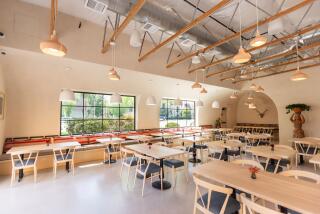Patient’s family cites earlier case of superbug at UCLA
UCLA hospital officials said they began investigating the possibility of a deadly bacterial outbreak in mid-December, but one patient’s account suggests they missed a chance to discover the problem much earlier.
That patient, an 18-year-old man still hospitalized at UCLA Ronald Reagan Medical Center, was first diagnosed in October with the drug-resistant superbug CRE after he was treated with a medical scope tied to outbreaks at hospitals across the country, his attorney said Thursday.
UCLA declined to discuss specific patients but said it acted swiftly as soon as it discovered the problem. According to its timeline, the hospital identified the first patient in mid-December and immediately launched a full-scale investigation.
Officials said it took until Jan. 28 for doctors to confirm the infections were tied to the medical scopes used in endoscopic retrograde cholangiopancreatography, or ERCP.
Some medical experts caution that it can be difficult to connect the dots when an initial case pops up. The hospital said seven patients were infected and 179 more may have been exposed.
Los Angeles attorney Pete Kaufman said his client was diagnosed with CRE in October at the hospital. He declined to identify the patient by name. The San Fernando Valley man became infected after he was treated with a duodenoscope.
The patient recovered and was released in January, Kaufman said. The man returned to UCLA that same month and got re-infected with CRE after undergoing a second scope, according to the family.
Kaufman said he’s still being treated at UCLA and his prognosis for recovery is good.
For their part, Kaufman said the patient’s family blames the medical device manufacturer, not UCLA, for the infection.
“We don’t think that UCLA did anything wrong,” he said. “Based on the early investigation we think it is the fault of the manufacturer for not determining an effective cleaning protocol” for the medical scope used.
At a news conference Thursday, UCLA officials made no mention of a CRE case in October while discussing their investigative timeline. A university spokeswoman declined to comment on any specific patients and their treatment, citing patient confidentiality.
Dr. Zachary Rubin, medical director of clinical epidemiology and infection prevention at UCLA Medical Center, said the hospital is always on the lookout for the CRE bacteria but didn’t see any sign of a bigger problem until December.
Some medical experts said that confirming the link between CRE and the scopes often takes extensive detective work and sifting through numerous causes for an infection. L.A. County health officials also defended UCLA’s response to the outbreak.
“I want to commend the strong work by my colleagues at UCLA in detecting the outbreak and preventing further cases from occurring,” said Dr. Benjamin Schwartz, deputy chief of the acute communicable disease control program at the L.A. County Department of Public Health.
Dr. Bret Petersen, a professor of medicine in gastroenterology and hepatology at the Mayo Clinic in Rochester, Minn., said a single case of CRE in October wouldn’t necessarily raise red flags because the bacteria can be picked up many different ways in a hospital.
Petersen said it can take weeks or months for an infection to develop in patients and symptoms can vary from fever and chills to an infection in the lungs or urinary tract.
“If you experience one case at a time over a few months it’s not so clear-cut,” Petersen said.
Meanwhile, other patients and their families worried about what the outbreak means for them and contended that UCLA should have alerted them sooner.
Bakersfield resident Sheila Adamczyk said she called her daughter’s doctor Thursday, searching for answers after seeing news of the outbreak.
Her 16-year-old daughter, Bailee, was treated with a scope similar to the ones involved in the outbreak at UCLA in October and again in December related to a cancer screening.
“I want to know what the hell is going on and I want to know right now,” Adamczyk said. “They had two deaths. They knew this had taken place.”
The hospital said it had notified the majority of the 179 other patients who may have been exposed from Oct.3 to Jan. 28.
UCLA Health System President David Feinberg apologized for the outbreak that contributed to two deaths, five other infections and widespread distress in the community.
“Our hearts go out to the families of the two patients who passed away and to the patients who are infected and to the ones who are having anxiety awaiting their test results,” Feinberg said.
Nationally, about half a million patients each year undergo ERCP procedures, in which doctors thread a specialized endoscope down the patient’s throat to examine and treat cancer, gallstones and other issues in the digestive system.
CRE, which stands for carbapenem-resistant Enterobacteriaceae, are germs that have become difficult to treat because they are resistant to most antibiotics.
The bacteria can lead to death in up to 50% of patients who become infected, according to the CDC.
UCLA said it hasn’t had any further infections since it changed its decontamination procedures for the endoscopes involved.
After the outbreak, UCLA switched to gas sterilization of its duodenoscopes. Some other hospitals have turned to that technique in the wake of similar outbreaks at other hospitals across the country since 2012.
Olympus, the market leader in duodenoscopes, said in a statement Thursday that it is making available to its customers supplemental educational materials, including an interactive checklist with video demonstrations.
“We are working with the FDA, relevant medical societies and our customers regarding these concerns,” the company said.
Q&A: What makes CRE superbugs so dangerous?
How safe is your hospital? A look at California ratings
Let us know if you have been affected by the outbreak at UCLA
chad.terhune@latimes.com
javier.panzar@latimes.com
melody.petersen@latimes.com
More to Read
Inside the business of entertainment
The Wide Shot brings you news, analysis and insights on everything from streaming wars to production — and what it all means for the future.
You may occasionally receive promotional content from the Los Angeles Times.













